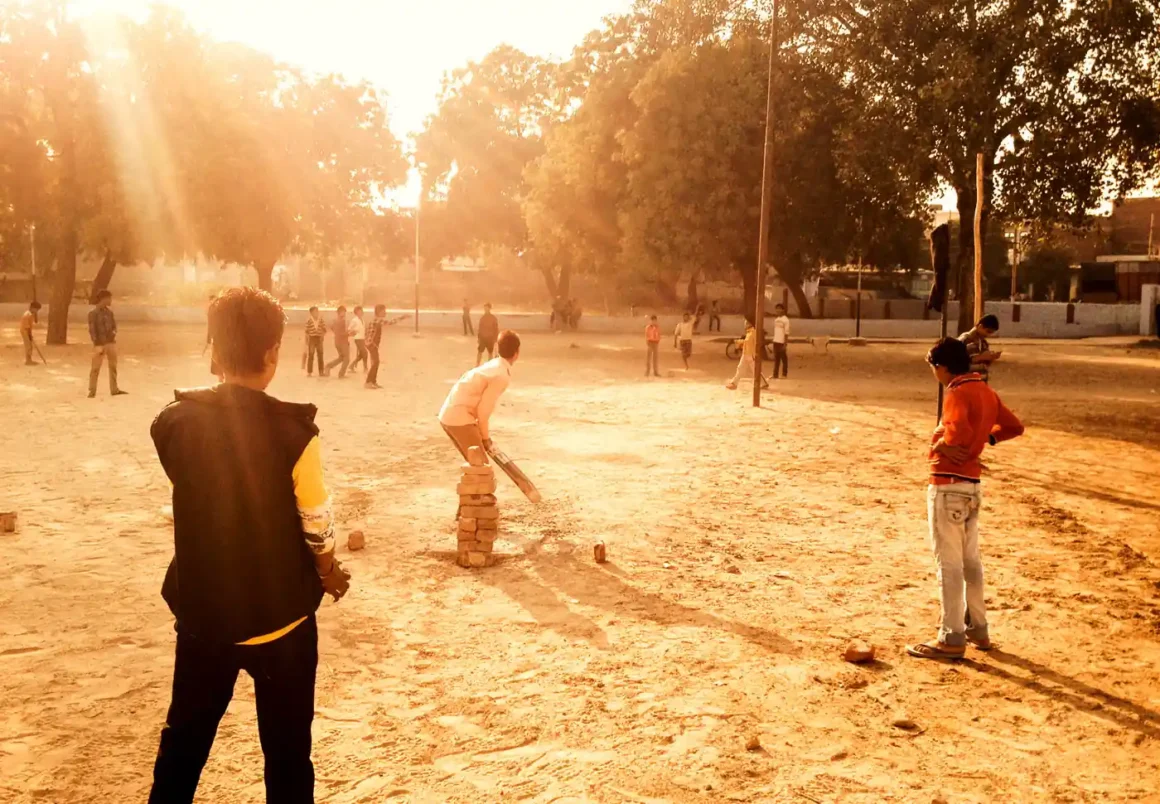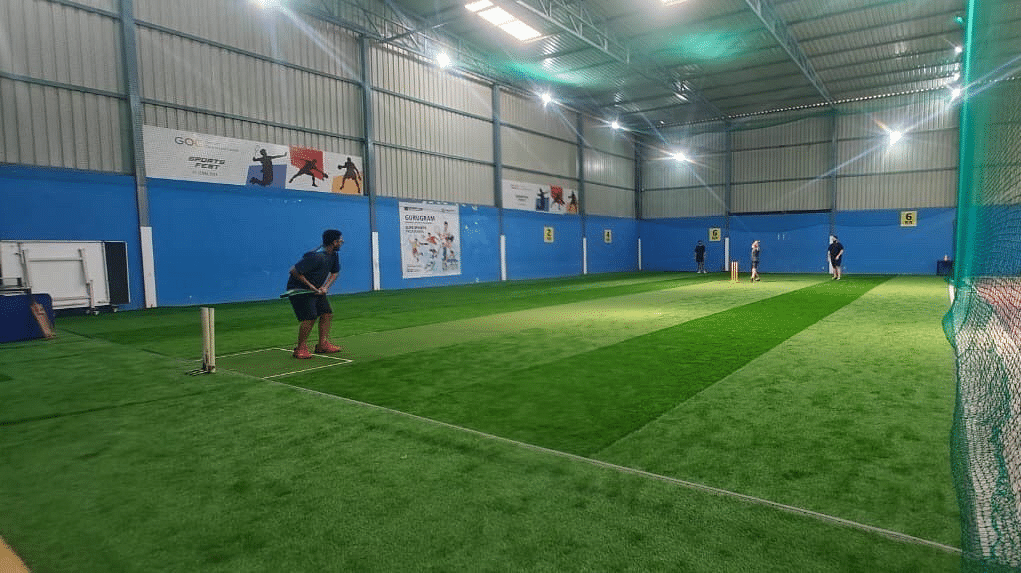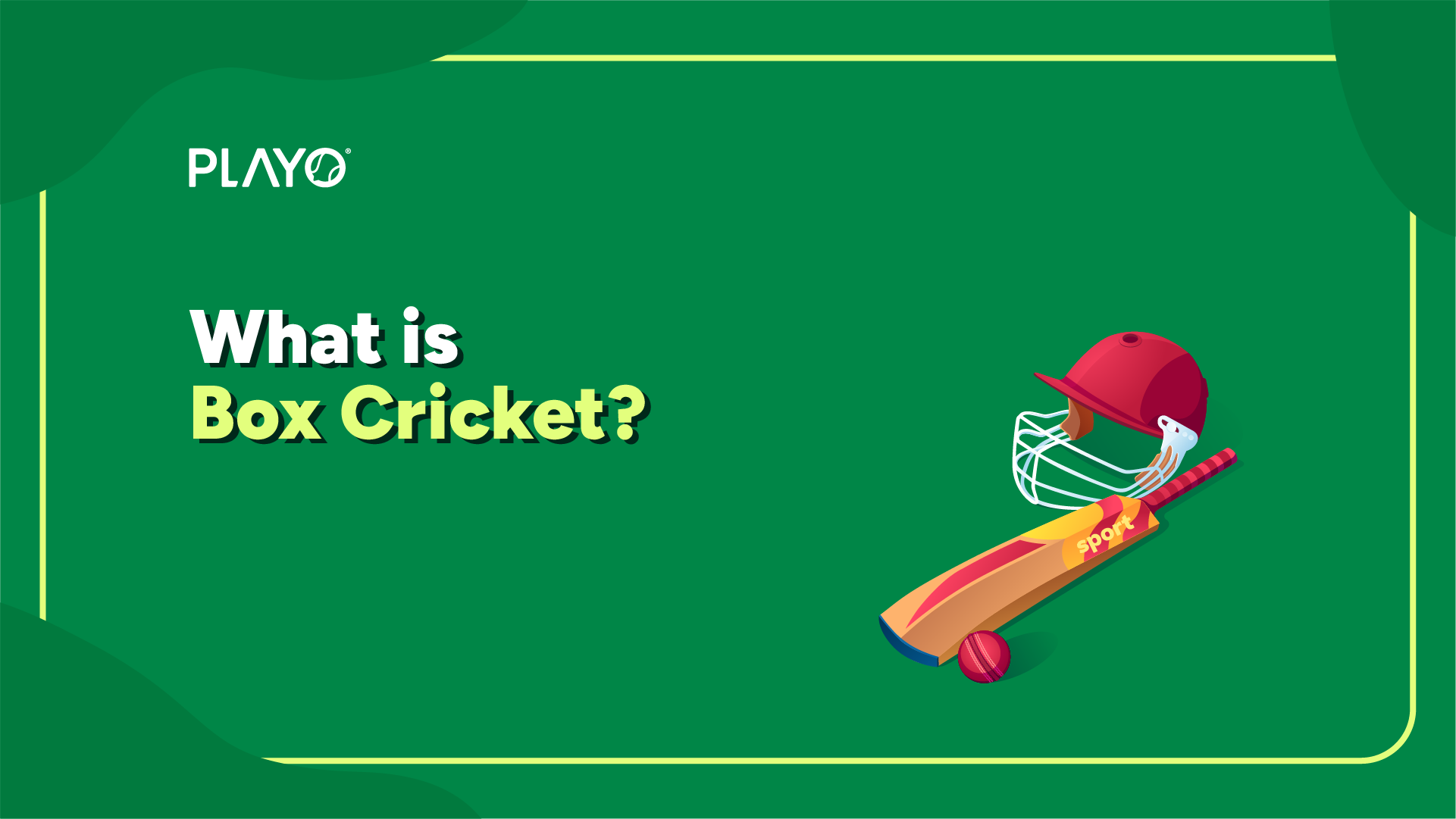Box cricket is a modified, fast-paced version of cricket played in a confined indoor or outdoor space, commonly called a “box,” with a standard team size of 6 to 8 players per side. Unlike traditional cricket, which requires an 11-player squad and a large oval field, box cricket is designed for compact arenas such as indoor sports halls, parking lots, or rooftop courts.
The game features a full batting-bowling-fielding structure but eliminates long running between wickets. Instead, runs are scored by hitting designated walls or zones. For example, 4 runs for the side walls and 6 runs for the back wall. Matches are short, typically lasting 30 to 60 minutes with 6 to 10 overs per innings, making it ideal for urban players seeking quick, high-energy action. In India, especially in metro cities like Mumbai, Delhi, Bangalore, and Chennai, box cricket has surged in popularity because it merges the raw energy of gully cricket with organised, rule-based competition.
Origins of Box Cricket – From Streets to Structured Arenas

Box cricket didn’t start with a rulebook. The roots of box cricket lie in India’s iconic street and gully cricket culture. As cities grew and access to full-size grounds became scarce, enthusiasts improvised by bringing the game to terraces, small lots, gymnasiums, and parking spaces. This need for an urban alternative led to more structured games in enclosed or netted areas, which eventually evolved into formal indoor leagues and commercial box cricket venues.
In box cricket, runs can be awarded based on hitting specific sides or back walls, while penalty runs or negative runs are enforced for various dismissals (like getting caught or sending the ball outside the enclosure). Local leagues often introduce creative rule variations to fit their arenas, making the game both familiar and refreshingly new.
Box Cricket Rules, Scoring, and Gameplay
Box cricket’s rules are streamlined for speed and fun. The following box cricket rules focus on simplified gameplay, limited overs, and indoor-friendly adaptations that make the sport exciting in compact spaces.
- Teams consist of 6–8 players.
- Matches are usually 6–10 overs per side (sometimes as few as 3).
- Over limits: Each player might bowl a maximum of 2 overs.
- A ball delivered above a specific height is a no-ball (height marker varies per venue).
- Walls act as boundaries: hitting a wall can count as 4 or 6 runs; direct hits to the back net/wall may grant bonus runs.
- Running between wickets is optional or limited, depending on venue rules.
- Batting retirements or order restrictions are common- for example, a player retires after scoring a set number of runs.
- Dismissals typically include caught (even off nets/walls), bowled, run out, and sometimes special local rules (like three consecutive dot balls = out).
- Penalty runs may be deducted for dismissals, such as -5 runs per wicket.
- No leg before wicket (LBW), and extras like wides and no-balls add bonus runs.
Read More: Box Cricket Dimensions
Box Cricket Ground Size and Equipment

Playing area of Box Cricket:
- Length: 40 to 50 feet (12 to 15 meters)
- Width: 25 to 30 feet (7.5 to 9 meters)
- Ceiling Height (Indoor): 10 to 12 feet (3 to 3.6 meters); Outdoor net height can go up to 25 feet (around 7.5 meters)
- Pitch Length: 18 to 22 yards (16.5 to 20 meters); often matches traditional cricket where space allows, but may be slightly shorter for some indoor setups
Box Cricket Equipments:
- Lightweight cricket bat
- Soft tennis ball or indoor cricket ball (to reduce injury and wall damage)
- Stumps or portable wickets
- Optional: batting gloves, helmets (in competitive leagues)
- Most commercial venues provide gear, so all you need is a team and enthusiasm
How to Play Box Cricket
Looking to get started in box cricket?
- Book an official box cricket court or set up an enclosed/marked area.
- Form two teams of 6–8 players.
- Decide the number of overs and batting order before play begins.
- Agree on local boundary rules (what counts as four/six, dead zones, etc.) and height restrictions for legal deliveries.
- Play, focusing more on placement than sheer power, since boundaries are close.
- Equipment: Use a tennis or soft cricket ball and lightweight bats designed for indoor/outdoor use.
Key Differences of Box Cricket vs Traditional Cricket
Box cricket’s core appeal lies in its fast pace and accessibility, especially compared to lengthy conventional matches. Let’s compare some key features of both forms.
| Feature | Box Cricket | Traditional Cricket |
| Players per team | 6–8 | 11 |
| Match duration | 30–60 mins | Hours to days |
| Field size | 12–15m x 7.5–9m (40–50ft x 25–30ft) | 137–150m diameter |
| Boundaries | Walls/marked lines | Rope/fence |
| Running | Limited/optional | Full running |
Popular Box Cricket Formats and Leagues
- The Box Cricket League (BCL)- a celebrity-driven, televised tournament launched in 2014 that played a pivotal role in bringing box cricket into the mainstream. By blending sports with entertainment and featuring Bollywood stars, TV personalities, and influencers, BCL sparked nationwide interest and inspired countless local adaptations.
- 5-a-side and 6-a-side matches, designed for quick gameplay and easy team assembly, making them ideal for weekend tournaments or office events.
- Turf-based box cricket tournaments, held on artificial or synthetic surfaces that mimic real pitch conditions while fitting into compact urban venues.
- Corporate leagues, where professionals form teams for after-work matches, foster camaraderie, fitness, and friendly competition.
- Grassroots local leagues thriving in cities like Mumbai, Bengaluru, Chennai, Delhi, and Hyderabad, often organised by sports startups, housing societies, or community clubs.
Corporations, youth groups, and sports enthusiasts love box cricket for its quick setup and ability to fit high-energy play into short sessions.
Why Box Cricket is Perfect for Urban Players
Box cricket solves the biggest hurdles of city life:
- Accessible: No big ground needed, all you need is just a booked court
- Affordable: Low cost per player (often under ₹100)
- Time-Efficient: Full match in under an hour
- Social and Fun: Great for friends, colleagues, or family
- Fitness-Friendly: Boosts reflexes, coordination, and cardio
Whether you’re unwinding after work or planning a weekend hangout, box cricket delivers adrenaline, laughter, and friendly rivalry, all in a compact, controlled space.
Conclusion
Box cricket is more than a scaled-down game. It’s a cultural phenomenon for urban India. Fast, inclusive, and endlessly adaptable, it brings the joy of cricket to everyone, everywhere.
Now that you know what box cricket is, why not try it? Gather your squad, book a court on PLAYO, and experience the thrill firsthand!
Download Playo on Android or iOS, or visit playo.co to start playing!
Frequently Asked Questions
Matches typically consist of 6 to 10 overs per side, though the exact number can vary depending on the league, venue, or tournament format.
A box cricket ground typically measures about 40–50 feet in length and 25–30 feet in width, requiring around 6,000 to 10,000 square feet of enclosed space with nets or walls 10–12 feet high indoors to keep the ball contained and ensure safety.
A soft tennis ball or a specially designed indoor cricket ball is used to ensure player safety and better control in confined, often walled, playing environments.
Teams usually consist of 6 to 8 players, though 5-a-side formats are also common, depending on local rules and tournament structure.
Box cricket can be played both indoors and outdoors, but it is most commonly played indoors in enclosed, netted arenas with walls that define boundaries and enable consistent gameplay.
Runs are primarily scored by hitting designated walls or zones, such as 4 runs for striking a side wall and 6 for hitting the back wall. Physical running between wickets is rare; most runs come from boundary hits. Some formats also include penalty runs for dismissals or rule violations.





0 Comments